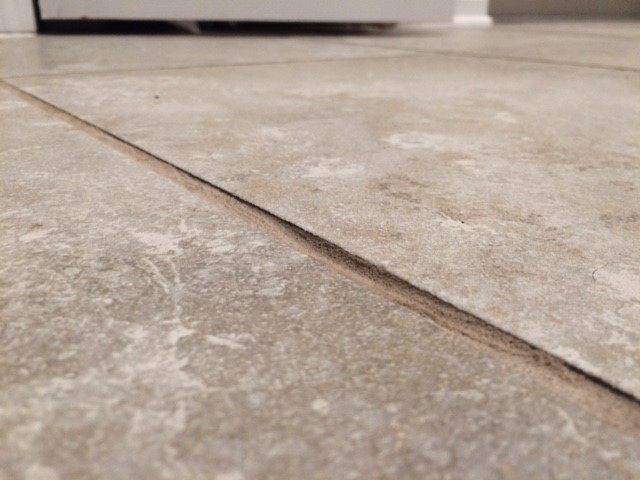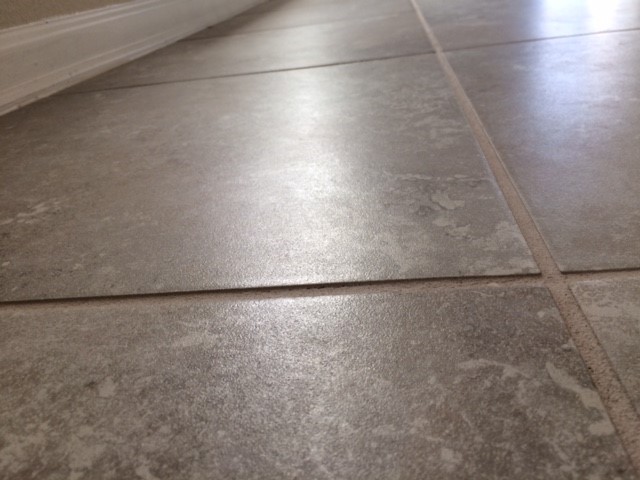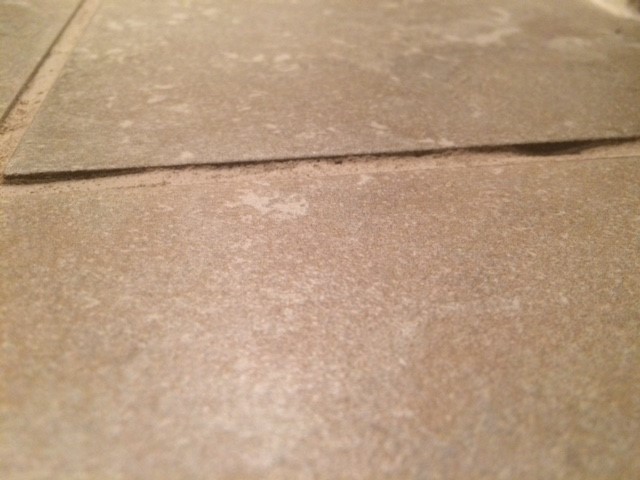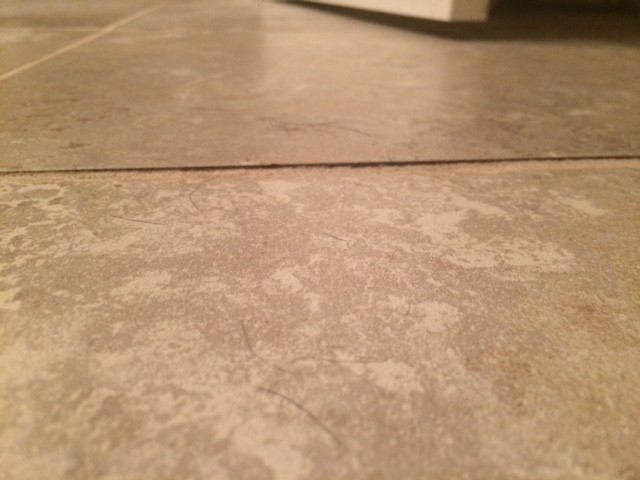
Have you looked at the photos in this article and noticed a real problem? They all demonstrate low grout joints which do not meet the tile industry standards. To meet these standards, the grout must adequately fill the space which obviously these examples do not.
And yet, when the person who took these photos shared them with his builder on the job site, the builder did not believe that any standards existed or that there were any organizations that develop them.
Have you found yourself in a similar situation?
If yes, here's how to deal with low grout joints and understand tile installation standards.
In this article, we'll address the following topics:
Selecting the right grout for your tile installation
Dealing with low grout joints
Who sets Tile Industry installation standards?
Want to become involved in tile installation standards development?
Questions and comments from readers
Are you now better equipped to address low grout joints?
Selecting the right grout for your tile installation
Before addressing low grout joints, let's briefly explore the types of grout available. In both the TCNA Handbook and the NTCA Reference Manual, you'll find the Grout Selection Guide which details the different products and considerations based on the type of tile selected and the exposure in which it will exist.
More specifically,
- Sand-Portland Cement Grout (made on the job using sand and cement)
- Standard Cement Grout (unsanded and sanded)
- High Performance Tile Grout (unsanded and sanded)
- Grout Color Selection
- Stain Resistance and Color Consistency of Cementitious Grouts
- Epoxy Grout (100% solids)
- Epoxy Emulsion Grout
- Furan Resin Grout
- Premixed Polymer Resin Grout
As the TCNA Handbook Grout Selection Guide explains,
"Portland cement is the base for most grouts and is modified to provide specific qualities such as whiteness, mildew resistance, uniformity, hardness, flexibility, and water retentivity. Non-cement-based grouts such as epoxies, furans, and premixed polymer resin grouts offer properties not possible with cement grout. However, special skills and precautions on the part of the tile setter may be required."
Be sure to read through the guide so you select the right grout for the job.
>> See Do You Ignore Grout Manufacturer Directions?

Dealing with low grout joints
In this situation, although the type of grout selected for the project may not have been the best, we're focusing primarily on the unacceptable installation practices seen here.
>> See How Not to Install Tile on Floors, Walls, and in Showers
Also, visit The Tile Installation Experience with Scott Carothers at Coverings.
ANSI A108.10: The Standard for Installation of Grout in Tilework
The ANSI (American National Standards Institute) Specifications for the Installation of Grout in Tilework provide critical guidance for how grout is to be applied and finished.
>> See ANSI Standards: A Tile Installer's Best Friend!
A valuable overview is provided in ANSI A108.02, General Requirements for Materials, Environmental, and Workmanship. This section covers the components used in tile assemblies and determining the size of grout joints.
In terms of the proper fullness of grout joints, ANSI A108.10 is the standard for Installation of Grout in Tilework. A108.10 section 5.3.4 requires that,
“All grout joints shall be uniformly finished. Cushion edge tile shall be finished evenly to the depth of the cushion.”
Check the NTCA Reference Manual chapter on Grout
The National Tile Contractors Association (NTCA) publishes the highly regarded NTCA Reference Manual that covers nearly every aspect of tile installation in a problem, cause, and solution format. It can and should be used by all tile contractors to understand potential issues with tile installations and how to avoid or recover from problems.
>> See NTCA Reference Manual: An Invaluable Tool for the Tile Industry
Chapter 8 of the 2017/2018 NTCA Reference Manual talks about Grout. Page 211 includes a discussion about the Problem, Prevention, and Cure associated with Low Grout Joints.
"Low Grout Joints" are defined as not being up to the top edge of the tile or cushioned edge, depending on the profile. Some of the problems leading to low grout joints include,
- Joints that aren't filled properly during application
- Using too much water and washing the grout out of the joints
- Using a soft float or sponge during the grouting process
- Joints settling as a result of voids under the edges of the tile
- Improper selection of grout for the specified use, and size of the joint
- Strong acid cleaning or using acid too early after grouting
The NTCA Reference Manual addresses each of these problems with prevention and cure recommendations.
The chapter on Grout also covers issues such as pinholes, powdery or soft joints, rough textured joints, inconsistent color, crazing and/or cracking, and efflorescence.

Who sets Tile Industry installation standards?
As we've previously discussed in this blog, the Tile Industry works closely together to ensure, given the rapid pace of change in products and materials, that installation standards deliver the best possible performance.
>> See The Top Tile Associations and Organizations
To that end, representatives from all facets of the industry participate in the development and writing of standards including representatives from the NTCA, the world’s largest association of tile contractors. They are members of the committees that write the standards, methods, and details that are recognized, highly regarded, and utilized by the tile industry.
>> See How Qualified Tile Contractors Participate in the NTCA Technical Committee
The industry's installation details are found in the Tile Council of North America (TCNA) Handbook and the standards are found in the American National Standard Specifications for the Installation of Ceramic Tile (ANSI A108, 118, 136.1, 137.1, 137.2, and 137.3).
Be sure to review the TCNA FAQs on Grout and Grout Joint Size.

Want to become involved in tile installation standards development?
If you'd like to become involved in supporting the Tile Industry, here are a few steps to consider.
- Membership in the NTCA is a valuable resource for all professional tile contractors or any contractor who installs tile. The primary mission of the NTCA is training based on these tile industry standards and it is committed to improving the installations and performance of contractors throughout the United States. Every installer should own and be familiar with the standards, methods, and details that guide the tile industry.
- Become a CTEF Certified Tile Installer (CTI). The Ceramic Tile Education Foundation (CTEF) provides education and training for tile setters and encourages them to become certified. The CTI program is a highly sought-after certification for tile installers who wish to achieve a higher level of professionalism and recognition in the tile industry. As a CTI, you set yourself apart from the crowd and know how to anticipate tile installation problems before they occur. Do it right the first time and get paid accordingly.
>> See How to Deal With Tile Installation Problems?
Questions and comments from readers
Since publishing this article in 2017, readers have asked several questions that Scott Carothers responds to:
It Depends on What Type of Grout You're Using
Edward Szramski comments,
What I have found is the grout is not allowed to set up a little (when are you going to be done) wiped wet thus pulling a good portion out!!
Here is Scott's response:
The ANSI Specifications establish basic guidelines for the grout materials and their installation procedures, but the manufacturer’s written directions always take precedence. The tricky part in your statement is that it depends on what type of grout is being used. Portland cement grouts must be permitted to set up in the joint, allowing the moisture to hydrate out of the system before the cleaning process begins.
As you have indicated, early washing of this grout type can wipe the grout out of the joint making it lower than is acceptable. However, epoxies, furans, and premixed polymer resin grouts must be treated in different ways, so always read and follow the manufacturer’s instructions to the letter.
>> See Do You Ignore Grout Manufacturer Directions?
Have a Pre-Installation Mockup
Larry Munsee explains,
I am seeking definitive industry standards with respect to grout installation for 12 x 18 rectified porcelain ceramic tile.
I have a new house that the tile was installed on the concrete floor. There are clear indications of lippage as well as irregularities concerning grout fill and grout width, i.e., width between tiles and fill. As stated, the grout is rectified porcelain ceramic tile so there isn't a pillowed edge. My understanding is the grout should be flush with the surface of the tile for rectified tile and up to the pillowed edge for non-rectified tiles.
The contractor/ tile company representative stated first there were no "industry standards," and then backpedaled when I confronted him with web sources. So far, he refused to correct the fill problem and first stated he would replace six tiles for lippage then changed to up to one hundred tiles but refused to address the low grout joint problem. Because of the lippage and poor fill, the tile cuts at your bare feet. It is a warranty issue since is a new house barely five months old. Any help would be greatly appreciated.
Here's what Scott recommends,
Unfortunately, you have experienced issues with your new home tile installation, but the solution to the mentioned areas needs to be discussed between you and your builder/tile contractor.
The ‘expectation’ of a flush grout joint to the square edge of the rectified tile should have been demonstrated in a grouted mockup to which all parties involved would have agreed with a signature and date of approval. Without a pre-installation mockup, solving this situation may be difficult.
>> See Why a Tile Installation Mockup is Really Necessary
Generally, a flush joint is desired on any square-edged tile (including rectified tile), but the ANSI standard found in A108.10 section 5.3.4 states,
“All grout joints shall be uniformly finished. Cushion edge tile shall be finished evenly to the depth of the cushion.”
Confirm Regrouting with the Manufacturer
Helen Weiss asks,
Can you regrout floor tile 3 times? It appears the contractor used epoxy grout but may have made it too watery since even with two applications, I can feel the edges of the tile. The grout is lower. Should grout be flush with the porcelain floor tile? Thank you.
Scott explains,
As stated in the first answer above, the manufacturer’s recommendations always take precedence. It would be best to contact the grout manufacturer to determine is regrouting is possible. The use of epoxy grouts does allow a second layer of epoxy grout to be applied over the first layer, but again these details need to follow the manufacturer’s recommendations.
ANSI A118.3 Chemical resistant, Water Cleanable Tile-Setting and Grouting Epoxy (100% Solids) grouts are installed by using sufficient pressure to pack the joint with the use of a hard rubber float. When cured, the epoxy grout may have a contoured depression (grout joint) of no greater than 3/64” (1 mm) for a 1/4:” (6mm) wide joint. This means that according to the ASNI epoxy grout standard, the grout will not be flush with the face of the tile.
Additionally, it is not possible for epoxy grouts to be watery since no water is added in the mixing process and the pre-measured components don’t allow any variability during mixing.

Are you now better equipped to address low grout joints?
Have you seen this problem in the field? How did you respond? Do you feel better prepared to address low grout joints the next time you encounter them?
Please send your comments.
Thanks for reading.
Note: This article was originally published on September 5, 2017, and has been updated.

